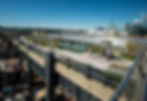Significance of public spaces and landmarks in architectural history
- Dream Space
- Dec 24, 2022
- 3 min read

Public spaces and landmarks play a vital role in the fabric of our built environment and in shaping the character and identity of our cities and towns. From ancient civilizations to the present day, these spaces and structures have served as centers for social interaction, cultural expression, and community building. In this article, we will explore the significance of public spaces and landmarks in architectural history, examining their functional and aesthetic importance, and considering the challenges and opportunities they present in the contemporary context.
Historical Overview :
Public spaces and landmarks have a long and varied history, reflecting the diverse needs and values of the societies that have created them. In ancient civilizations such as Greece and Rome, public spaces served as the center of political, economic, and social life. The Greek agora, for example, was a central open space used for a variety of purposes, including markets, meetings, and public assemblies. Similarly, the Roman forum was a multi-purpose space used for legal proceedings, public speeches, and religious ceremonies.

Throughout history, public spaces and landmarks have continued to evolve in response to changing societal needs and values. Medieval squares, for example, often served as centers of trade and commerce, while parks and gardens of the 18th and 19th centuries were designed to provide a respite from the crowded, polluted cities of the Industrial Revolution. In the modern era, public spaces and landmarks have taken on a variety of forms and functions, ranging from the grand boulevards of Paris to the bustling street markets of Asia.
Functional and Aesthetic :
Public spaces and landmarks play a number of important roles in our built environment. At their most basic level, they provide places for people to gather, socialize, and interact with one another. In this sense, public spaces serve as the glue that holds communities together, fostering a sense of belonging and connection among individuals.
Public spaces also serve as centers for cultural and artistic expression, providing a platform for the performance of music, dance, and other forms of entertainment.

Landmarks, in particular, often serve as symbols of a city or region's identity and history, representing the values, culture, and achievements of a particular place.
From an economic perspective, public spaces and landmarks can also be important drivers of tourism and economic development. Landmarks in particular are often major tourist attractions, drawing visitors from around the world and providing a source of income and employment for local residents.
Contemporary Challenges and Opportunities :
In the contemporary context, public spaces and landmarks face a number of challenges and opportunities. One of the most pressing challenges is the need to create accessible, high-quality public spaces in the face of rapid urbanization. As cities continue to grow and densify, it becomes increasingly important to ensure that there are sufficient public spaces available to meet the needs of a growing population.

Another important challenge is the need for inclusive design, which seeks to ensure that public spaces are welcoming and accessible to all members of the community, regardless of age, ability, or cultural background. This includes designing spaces that are physically accessible to people with disabilities, as well as ensuring that public spaces are culturally relevant and welcoming to diverse groups of people.
In addition to these challenges, public spaces and landmarks also present opportunities for preservation and revitalization. In many cases, historic landmarks are under threat from neglect, development, or other factors, and it becomes important to preserve these structures for future generations. At the same time, there is also an opportunity to revitalize and reimagine these spaces, finding new ways to make them relevant and meaningful to contemporary society.